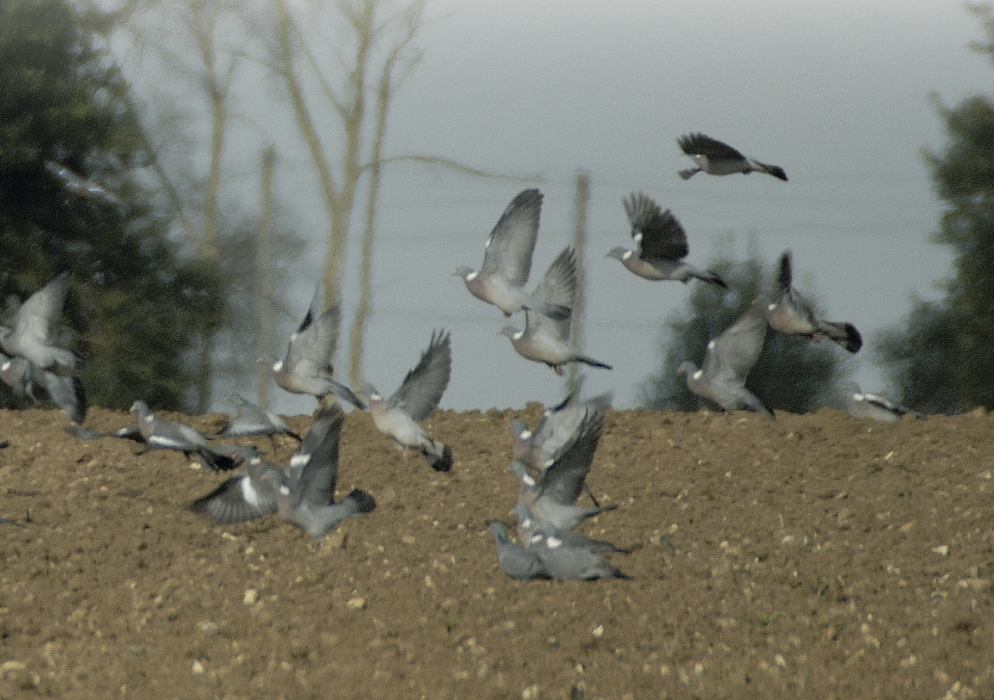Where did the woodpigeons go?

To be a consistently successful pigeon shooter, you have to be good at predicting events, from when birds are likely to take an interest in certain crops, to what the weather is going to be on the day you choose to shoot. But this only works if you have a large resident population of pigeon. What happens if, for some unknown reason, the birds disappear?
It has never been proven whether pigeon migrate to or from the UK at certain times of the year. We know from the limited ringing returns that birds move within the UK and that a small number make the journey across the English Channel, but returns indicate that most pigeons are shot within 10 miles of where they were hatched. So where do those vast flocks that turn up in some winters come from if not from abroad, and why do they move in the first place? The old timers insisted these new arrivals were from the pine forests of Scandinavia and were easily distinguishable by the lack of white collars on their necks, but it has been established that these birds were simply juveniles that had massed together in their customary winter flocks. Also, nobody in Scandinavia has witnessed the return of these “collarless” pigeons in the spring.
A pigeon theory
So, in the absence of scientific proof, I can only offer my theory as to what happens when big numbers of pigeon either appear in your area or disappear from your area. Most birds and animals have a far keener sense of where to find their next meal than humans. It enables wild geese to find that old potato field 30 miles inland from where they roost, and teal to turn up overnight on a piece of freshly flooded grassland. If pigeon loved oilseed rape as much as some people say they do, there would be no need for them to move anywhere in the winter in order to find it because there is hardly a farm in the country that does not grow the stuff.
No, I think what instigates these internal migrations is the availability of natural food that is far more nutritional than rape – and that is acorns and beechmast. It is no coincidence that I have noticed big influxes of birds in years when there is a heavy acorn crop and they will quickly move on when it has been depleted. This winter is such a year. I was at a pheasant shoot in Sussex in the middle of November and the keeper reported thousands of pigeon turning up in a couple of days. Was this anything to do with the fact that his coverts consisted almost entirely of oaks, and the ground was inches deep in acorns? woodie numbers.
There will be countless estates like this where pigeon will stay, unseen, until all the acorns have been eaten.
Pigeon movement
Curiously, they never seem to do the return journey in the same big flocks. I have never witnessed them turning up from the west after finishing the acorns. But the fascinating thing is that hardly anyone sees “their” birds moving off either. You only ever see birds from elsewhere arriving, usually soon after dawn and from the east.
In this part of Essex, there have been years when the movement has continued for more than a week, always in November. Sometimes these birds use my little wood as a temporary base before moving on, ever westwards. I have tried decoying them, usually on late drillings, but the results are usually disappointing, because the birds are twitchy and reluctant to return to any particular field. My best results have come from standing in my wood at dawn and waiting for the flocks to arrive, the complete opposite from waiting for them at roosting time, when none turn up, having already moved on.
Most migratory birds, such as swallows or pinkfooted geese, all leave our shores when the urge becomes too great. You will never see a swallow in January, for example. But only a certain proportion of woodpigeon follow the acorns. Plenty of birds hang around my patch eating the natural crop before moving on to the rape once it is all gone. In most instances it is impossible to get at them in such a way as to kill large numbers, so at least they get a bit of a breather from us decoyers. Even my local gamedealer was asking where all the woodies have gone, having seen numbers brought into him drop from a peak of 10,000 a week in September, to none by the middle of November. He was shocked to learn that this situation was unlikely to change until January.
Enigmatic birds
Despite the development of modern technology, we know remarkably little about one of our most common birds. It is still a mystery why some pigeon travel hundreds of miles and others stay put. We are not even sure whether the birds that do move around are the same ones that return to approximately the place where they hatched. I imagine that the more urbanised pigeon become, the less likely they are to migrate to other parts of the country, even in big acorn years. Admittedly, that assumption is based solely on the two pairs of birds that live in my garden, who still turn up every day for their feed of peanuts.
An acorn feast
Last year was one of the most challenging for the decoyer with regards to how pigeon reacted to being chased from pillar to post throughout the winter and early spring. It remains to be seen if their behaviour returns to normal after enjoying a winter of peace and quietly stuffing themselves with acorns








